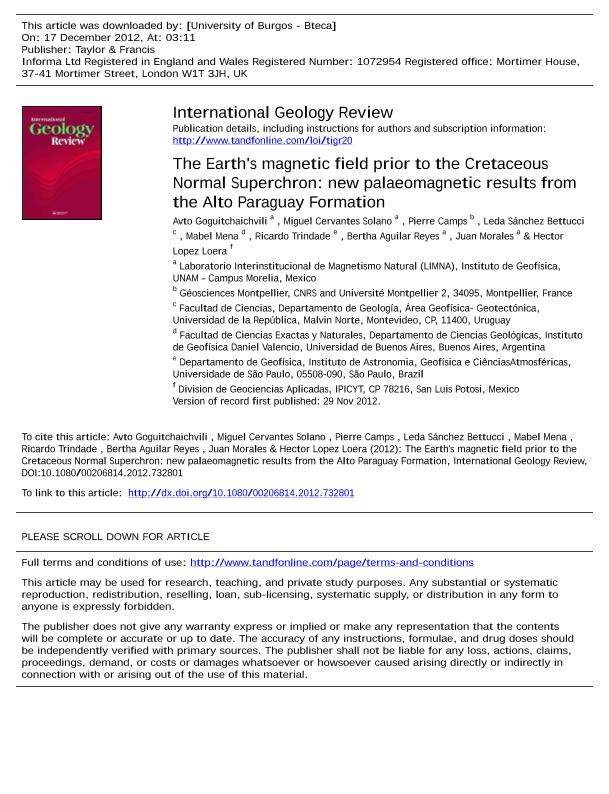Artículo
The Earth's magnetic field prior to the Cretaceous Normal Superchron: New palaeomagnetic results from the Alto Paraguay Formation
Goguitchaichvili, Avto; Cervantes Solano, Miguel; Camps, Pierre; Bettucci Sanchez, Leda; Mena, Mabel ; Trindade, Ricardo; Aguilar Reyes, Bertha; Morales, Juan; López Loera, Héctor
; Trindade, Ricardo; Aguilar Reyes, Bertha; Morales, Juan; López Loera, Héctor
 ; Trindade, Ricardo; Aguilar Reyes, Bertha; Morales, Juan; López Loera, Héctor
; Trindade, Ricardo; Aguilar Reyes, Bertha; Morales, Juan; López Loera, Héctor
Fecha de publicación:
04/2013
Editorial:
Taylor & Francis
Revista:
International Geology Review
ISSN:
0020-6814
Idioma:
Inglés
Tipo de recurso:
Artículo publicado
Clasificación temática:
Resumen
We report a detailed palaeomagnetic investigation of 28 lava flows (221 standard palaeomagnetic cores) collected from the Paraguayan part of the Paraná flood basalts (the Alto Paraguay Formation). The initial aims of our study were to (i) document variability of the Earth's magnetic field during the time interval sampled, (ii) obtain a new Early Cretaceous palaeomagnetic pole (PP) for stable South America, and (iii) estimate the extrusion rate of the Paraná magma. We precisely determined the palaeofield direction for 26 sites for which the characteristic remanent magnetizations exhibit small within-site dispersion and high directional stability. No palaeodirections were determined for two sites because of a very complex and erratic behaviour of the remanence during the palaeomagnetic treatments. Nine sites display normal polarity magnetization, whereas nine others are reversely magnetized and the remaining eight sites yield intermediate palaeodirections. The mean palaeomagnetic direction of normal polarity sites give I = -41.8°, D = 4.9°, k = 112, and α95 = 4.9°, whereas reversely magnetized sites give I = 37.1°, D = 181.4°, k = 23, and α95 = 11.1°. The reversal test as defined by McFadden and McElhinny (1990; Classification of the reversal test in paleomagnetism: Geophysical Journal International, v. 103, p. 725-729) is positive, corresponding to Type B with γ = 8.7° and γ0 = 3.7°. This ensures that the palaeomagnetic treatment successfully removed the secondary natural remanent magnetization and that the sampling adequately averaged the palaeosecular variation (PSV). The mean PP position obtained from 18 sites is palaeolongitude (Plong) = 359.2° and palaeolatitude (Plat) = 86.2° S. We show by means of probability plots and formal testing procedures that a Fisher distribution with a concentration parameter K = 65 satisfactorily fits the distribution of virtual geomagnetic poles (VGPs). The PP obtained in this study agrees reasonably well with coeval pole positions, in particular with those obtained from the Central Paraná Magmatic Province in Brazil, Los Adobes, and Misiones in Argentina. However, some other similar age PPs show significant departure that may be attributed to local tectonic rotations or insufficient sampling needed to overcome the PSV. This new PP differs slightly from the reference poles at 135 Ma for South America given by Besse and Courtillot (2002; Apparent and true polar wander and the geometry of the magnetic field in the last 200 million years: Journal of Geophysical Research, v. 107, no. B11, p. 2300). The PSV parameters are in agreement with those obtained from selected data reported for the Cretaceous Normal Superchron (CNS). In contrast, VGP angular dispersion found here is lower with respect to the Jurassic and Plio-Pleistocene data. The intermediate VGPs determined in the present geographical frame show a northern hemisphere cluster of seven VGPs located east of India, whereas one other VGP is located in the vicinity of Australia.
Archivos asociados
Licencia
Identificadores
Colecciones
Articulos(IGEBA)
Articulos de INSTITUTO DE GEOCIENCIAS BASICAS, APLICADAS Y AMBIENTALES DE BS. AS
Articulos de INSTITUTO DE GEOCIENCIAS BASICAS, APLICADAS Y AMBIENTALES DE BS. AS
Citación
Goguitchaichvili, Avto; Cervantes Solano, Miguel; Camps, Pierre; Bettucci Sanchez, Leda; Mena, Mabel; et al.; The Earth's magnetic field prior to the Cretaceous Normal Superchron: New palaeomagnetic results from the Alto Paraguay Formation; Taylor & Francis; International Geology Review; 55; 6; 4-2013; 692-704
Compartir
Altmétricas



